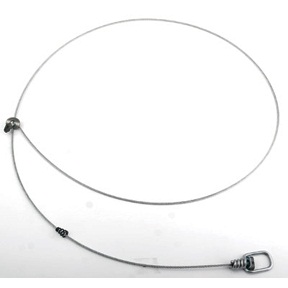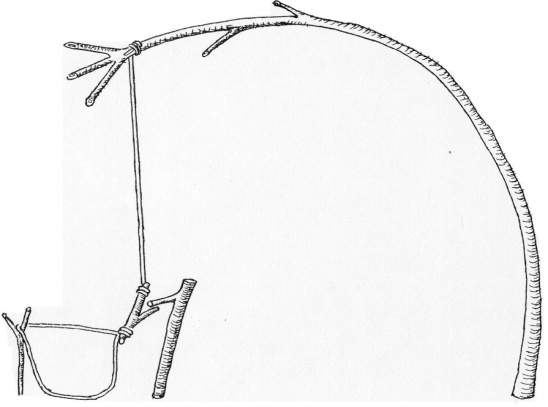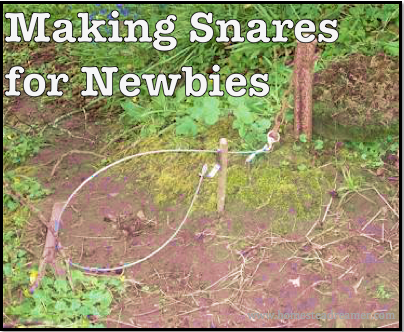What is a snare? What do they do? What are they made out of?
A snare is usually made out of some kind of wire with a loop on the end. Simply put, cut 18 inches of wire, make a loop at one end large enough to fit the other side through (to make the larger loop that will snare the animal) but small enough so it won’t let the animal slip free. Twine or rope have also been used but the wire retains its shape better and is harder to be chewed through. It’s placed in such a way that when an animal’s head goes through the loop, they are trapped. As they struggle, the loop gets tighter and the animal dies. Sorry, if you were looking for sugar coating, this is not that kind of article. I refuse to use pretty words and smooth over the less than pleasant reality of what it is to set snares and traps.
That being said, when you think about how most animals die, a snare tends to be a little more humane than being eaten alive. Snaring and trapping animals is something that should never be something taken lightly.

Making snares is pretty straightforward: at least the wire looping anyway. There are laws and regulations on both the federal and state (maybe even county) levels regarding what material is legal to use and when snares can be set during the year. Some require certain clamps or ‘stops’ to be placed on the snare so it won’t choke them right away. It is up to you to be informed for your particular area. If you are busted with an illegal set, the authorities really don’t care if you didn’t know because it is your responsibility.
Never, ever set a snare unless you intend on checking it and tending the animals you catch. It is an honor code, not only for the animals, but life in general.
There are several YouTube videos that will show you exactly how to make the snare while others will show you ways you can set the snare across game trails, using bait, and variations on those steps (depending on what you are trying to catch). Most people who hunt or trap small game with snares use a 24 gauge steel wire because it is thick enough to be strong but thin enough that you can still work with it. Still others prefer using brass wire because it is more forgiving and more easily bendable. Here is a link to a video and another one for an article with great pictures.
How do you set a snare? What else do you need?
There are as many ways to set a snare as there are animals: maybe even more! On a quick Google search, there were hundreds of thousands of links that would take you to videos, infographics, and guides on how to set a snare. There are triggered snares that utilize a bent sapling tree that, once sprung, will tighten the noose and pull the animal off the ground. There are others that are simply a loop set over a game trail with little sticks and branches on the sides of the loop. The sticks serve as a block that will ‘force’ the animal to go through the snare.
The only “right way” to set one is to make sure that it will close and hold when an animal goes through it. Every area is different, every game trail or burrow hole is different and that means you need to be creative to have a chance of success. I cannot stress this enough: there is no ‘one way’ to set a snare trap, so long as it does the trick. There are, however, things you need to consider every time.
- What am I trying to catch? (This may change the style of snare trap you set)
- Will I be able to come back within a few days and check this trap?
- Am I going to use a trigger or free-hanging snare?
- Is the area able to be altered a little to force the animal to the loop?
- Can I use a drag stick or does it have to be attached firmly to something?
There are many more, of course, but each person is different in their preferences and locations. Don’t let any one tell you that your way is ‘wrong’ if you have successfully trapped animals in a snare before. Just because someone else doesn’t do it the exact same way does not mean it is bad (unless illegal of course!).
As far as what else you may need, I would suggest making sure you have a good sharp knife, a firearm (if able) because the sounds of struggling animals tends to bring in larger predators and you don’t want to be caught unaware and unarmed, and wire cutters. Generally speaking, the longer the snare, the stronger it is but sometimes the landscape you are working with will call for something smaller or special adjustments to get the snare trap ‘just right.’ Many trappers will just bring along a whole pile of snares they made up and leave the rest at home.
Because they are so easy to make, it is wise to have a few of them already made and stored in your emergency bag, bug out bag, or vehicle bag. There are many uses for wire and snares other than trapping food. Wire, nylon cord, twine: all of these items can come in handy in a multitude of situations and are lightweight, taking up little to no space in your bags.
Resources to Learn More

There is plenty more to learn about when it comes to making snares, setting snares, and then what to do after you have gotten something snares. I don’t claim to know a lot or be an expert on the topic however, having the basics down puts you way ahead of the game. Here are some links to additional information I felt would be helpful for those who wanted to learn more.
Bushcraft Skills: Foraging for Food (includes info about trapping/snaring)
How to Build a Trap: 15 Best Survival Traps
How to Make a Locking Cable Snare for Trapping (video)




